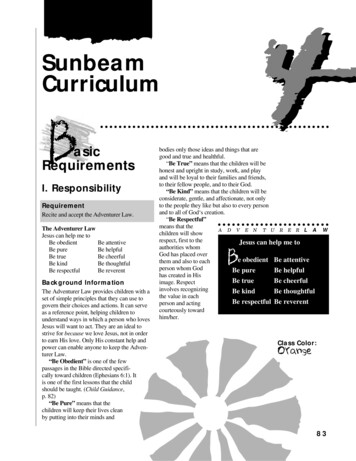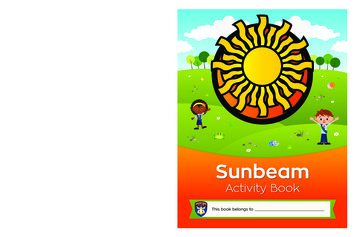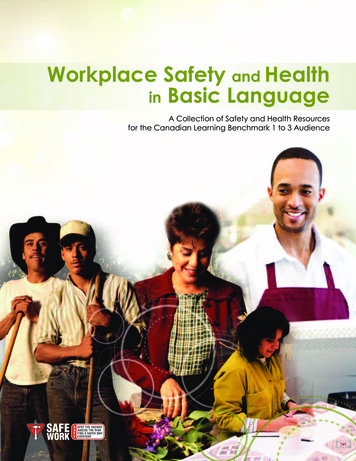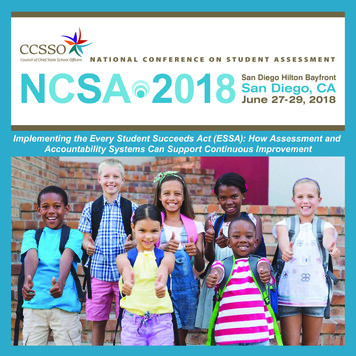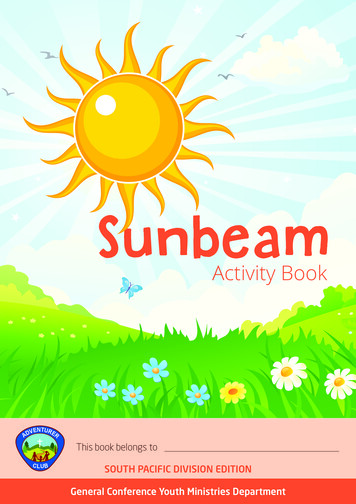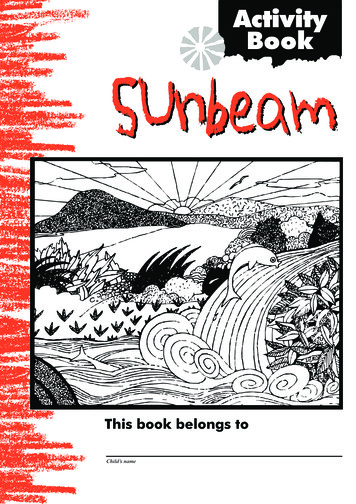
Transcription
ActivityBookij' SunbeamThis book belongs toThis book belongs toChild’s name
How to use this activity bookThis activity book is designed for ease of use by the parent or teacher, and tostimulate enthusiasm on the part of the Adventurer. This activity book may be used asa whole, or the pages may be removed and completed one at a time. Collecting the completed pages and binding them together (with stapler or yarn) at the end of the year will providea keepsake for the children to remind them of their Adventurers.Copyright 1996 North American Division of Seventh-day AdventistsRevised 2015 for the Northern Conference of Seventh-day Adventists131 Oxford RoadBedford Gardens2007 JohannesburgSouth AfricaEdited by Teresa ReeveDesigned by Glen MilamIllustrations by Orchard Hill Communications, CA.
ActivityBookfirst namelast namea Sunbeamfor er:me nuhonMy pThings that make mefeel sunny.1
NameDate StartedDate CompletedSunbeam ChecklistBasicRequirementsI.II.My SelfI.ResponsibilityRecite and accept theAdventurer Law.ReinforcementEarn the Sunbeam ReadingAward.My GodI.His Plan to Save MeA. Create a story chart orbooklet showing Jesus':BirthLifeDeathResurrectionOR the Bible stories you arestudying in your classroom orSabbath School.B. Use your chart or booklet toshow someone the joy ofbeing saved by Jesus.II. His Message to MeA. Memorize and explain twoBible verses about beingsaved by Jesus.Matthew 22:37-391 John 1:9Isaiah 1:18Romans 6:23Your choiceII.I Am SpecialMake a tracing of yourself.Decorate it with pictures andwords which tell good thingsabout yourself.I Can Make WiseChoicesPlay the “What-if?” gameIII. I Can Care for MyBodyEarn the Fitness FunAdventurer Award.B. Ask three people why theystudy the Bible.2The World of OtherPeopleA. Explore your neighborhood.List things that are good andthings you could help makebetter.B. From your list, choose waysand spend time making yourneighborhood better.III. The World of NatureEarn a Friend of NatureAdventurer Award.My FamilyI.I Have a FamilyAsk members of your familyto tell some of their favoritememories.II.Families Care forEach OtherA. Show how Jesus can helpyou deal with disagreements.Use:PuppetsRole-playingYour choiceIII. My Family Helps MeCare for MyselfComplete one requirement ofthe Road Safety AdventurerAward.B. Name the two major parts ofthe Bible and the four gospels.III. His Power in My LifeA. Spend regular quiet timewith Jesus to talk with Himand learn about Him.II.My WorldI.The World of FriendsComplete requirements #1and #6 of the CourtesyAdventurer Award.InstructorChecklistBasic RequirementsI.II.My GodI.A.B.II.A.B.III.A.B.My SelfI.II.III.My FamilyI.II.III.My WorldI.II.A.B.III.
It’s great to be partof an Adventurer Club.Adventurer Club will help you:give your life to Jesushave fun being a Christiana real Adventurer:is in grades 1-4attends meetings andactivities faithfullykeeps the Adventurer Pledgeand LawIn Adventurer Club, you’ll:earn awardsplay gamesmake frienshelp peoplego on outingsCome inif you wantAdventure!You can have an Adventurer Club:with your familywith kids at your churchwith kids at school or in your neighborhoodIf you don’t have a club yet, ask your mom or dad or an adult at church.3
Basic Requirements1ResponsibilityRecite and accept the Adventurer Law.lovesvery muchwantsverymuchandandwantsChild's namemeveryhappy.much andwantsto beThat'swhy He came as aChild's nameandforfor me.me.NowNowcan beChild's nameaand help other people betoo.too.Adventurer LawBe ObedientBe PureBe TrueBe KindBe RespectfulBe AttentiveBe HelpfulBe CheerfulBe ThoughtfulBe Reverent4
Make an Adventurer Law Booklet1. Cut on the black lines2. Fold on the dotted lines3. Put the pages together4. Staple on the dotted lines1Be ObedientBe Reverent103Be TrueBe Cheerful83Be RespectfulBe Attentive655
MyAdventurerLawJesus will help me to.69Be ThoughtfulBe Pure27Be HelpfulBe Kind4
Basic RequirementsReinforcementEarn the Sunbeam Reading Award.Read the book, then color the picture. Two (2) chaptersfrom MarkBook onfamily,friends orfeelingsBible storybook or a bookabout JesusBook on historyor missionsBook on health or safetyBook on nature7
Suggestions for Parents or LeadersThe Busy Bee Reading Award is awarded to childrenwho read or listen while someone else reads:Be sure that the books are:1. True to life. The books must present an accurate1. Two chapters from the Gospel of Mark, from a2.3.4.5.6.simple, modern translation of the BibleA Bible story book or a book about JesusA book on health or safetyA book on family, friends or feelingsA book on history or missionsA book on natureProvide children with several good books to choosefrom, which will help them to understand and applythe things they are learning this year in the Busy Beeclasswork.2.3.4.5.8picture of reality. It must not be overly simplistic,sentimental, or exciting.Lasting value. A good hook helps the child tounderstand God, human nature, or the things ofcreation without appearing to be preachy andcontrived.Positive Morality. Evil and sin are recognized assuch, and receive their just reward. The goodshould be upheld as the model and goal for thechildren.Enjoyable. The book should be one that the adultenjoys reading. (If the adult does not enjoy it, it ishighly unlikely that the child will—or should.)Developmentally appropriate. A good book will fitthe child's level of reading ability, sophistication,and interest.
My God1His Plan to Save MeA. Create a story chart or booklet showing Jesus’:BirthLifeDeathResurrectionORthe Bible stories you are studying in your classroom or SabbathSchool.B. Use your story chart or booklet to show someone the joy of beingsaved by Jesus.I showedSTEP!BYSTEPSunbeam Bible Story �ResurrectionssneenavHesmecousJes ainforag caresus ayJes todmead&SSin nigbentioeaCr9
Suggestions for Parents and LeadersBackground InformationThe Sunbeam requirement builds upon the Busy Beeemphasis on Jesus' love and care for us and His plan tosave us from evil. The basic concepts emphasized in thisrequirement are the ugliness of sin and evil and our needof Jesus' forgiveness for, and help in overcoming sin.The coming of Jesus to earth is one of the mostamazing events in the history of the universe. The Son ofGod came as a human being and suffered from the awfuleffects of sin in order to save the very sinner who destroyed His world by disobeying Him. He chose to beborn as a human child to a poor family to show us whatGod is like and what each one of our lives can be like ifwe follow Him. He acted in love toward people byfeeding and healing them and by telling them the excitingnews of His wonderful plan to rescue us from sin andmake us a part of His own kingdom.During His life on earth He demonstrated His love andforgiveness in many ways. He helped Mary Magdalene tounderstand His love and forgiveness and helped herchoose to live as a good and happy person. The paralyticmade himself sick from he bad things he had done, butJesus told him that his sins were forgiven. Jesus gave himstrength to get up and to live a good life. Jesus told thestory of the prodigal son to teach His followers that eventhough we may do many foolish things, He is alwayswaiting and eager to forgive us and help us to live morehappily.The horribleness of sin is shown by the willingness ofthe people to hurt and kill Jesus, the Son of God, in order10to get what they wanted for themselves. His death on thecross gave Him the right to forgive us and showed howmuch He really loves us. When He rose again He showedHis power over death and the life He will bring to all wholove Him when He comes again. (Stories from the classroom or Sabbath School Bible curriculum may be chosen toemphasize these same concepts, if you prefer.)The Bible Story Chart may be used in threedifferent ways:1. Place the pictures on a large wall story chart, addingeach new picture as you tell the story. The childrenmay refer to this chart as they work on their ownchart(s) and as they learn about other stories from theBible and history.2. Provide the children with a practice activity bymaking available a blank chart and the pictures,stories and labels provided on the following pages.The children may set the blank chart on the floor andplace the pictures, stories and labels in order on thechart.3. Children may also color the pictures and use thestories and labels to create their own story charts orstory chart booklets.ReviewReview the major events of earth's history introduced atthe Busy Bee level: creation, sin and sadness begin, Jesuscares for me today, Jesus comes again, and heaven.
Jesus’ BirthJesus, God’s Son, came to earth as ababy to help people.::a11
Jesus’ LifeJesus showed people how much Heloves them. He showed how happy wecan be if we obey Him.12
Jesus’ DeathJesus let evil men kill Him on a crossbecause He wanted to take away oursins.13
Jesus’ResurrectionJesus came back to life after three days.He is in heaven, now, watching over us.14
My GodHis Message to MeA. Memorize and explain two Bible verses about being saved byJesus.Match the texts with what they say.Matthew 22:37-39Jesus will forgive and help me ifI'm sorry for my sins.I John 1:9To love God and other people isimportant.Isaiah 1:18God wants me to live forever.Romans 6:23Jesus wants to make me cleaninside.Your choice15
B. Name the two major parts of the BibleNOTTand the four gospels.161. M3. L2. M4. L
My GodHis Power in My Life3A. Spend a regular quiet time with Jesus to talk with Him and learnabout Him.Color a square each time you finish a quiet time (or use stickers to fill your squares).Things to do:RYPRIMAesusFor JWith Who?akeMwwnNo ur O rtYo ChaWhen?Where?17
B. Ask three people why they study the Bible.I’ll askecause:e Bible bple study thPeoSuggestions for Parents or LeadersYour child needs your example and leadership as he triesto form good devotional habits.You can help by:Having your own daily quiet time with Jesus;enthusiastically sharing some of the inspiration and18insights you receive during your quiet time;leading out in family worship daily;helping your child choose a wise time and place forhis quiet time;being a part of your child's quiet time until he is ableand eager to continue on his own.
My SelfI Am Special1Make a tracing of yourself. Decorate it with pictures and words whichtell good things about yourself.You could write or draw about things you like, things you are good at, things you wish, andthings aboutyour family and friends.19
Suggestions for Parents or Leaders/The tracings can be made in two ways:1. If there is sufficient paper and space, haveeach child lie on a large sheet of butcherpaper while another child traces around hisbody with a watercolor marking pen.2. Tracings may also be done by using a stronglight to project a profile of each child onto apiece of paper that has been taped to the wall.Another child can trace around the shadowwith a pencil./Next, have each child describe himself\herselfusing some of the following ideas. This may bedone together at the teacher's direction, or variousideas may be written on cards for the children towork with individually. Drawings, cutout picturesor written words and phrases may be used.1. Child's name, its meaning, how parentschose it2. Physical Characteristicseye/hair colorlength of foot, hand, armfingerprint, footprintclothingageheightweightbirthday (earliest memory.)home addressphone numberheart rate (sitting, running)2. Likes and Dislikesfoodcoloranimalthings to do (alone, withfriends or family)game or sportbooktree or flowermonth or daynumberweatherholidayheroBible versepeopleBible characterplacesongsubjectthings to make204. FeelingsI sadexcitedrejectedafraidimportant5. Special Abilitiesbest/nicest thing I ever didthings I'm good atI feel good about me because.6. Ideas and Dreamsday dreamsthree wisheswhen I grow up I will be.I believe in.someday I hope.something I want to change about myselfis.in 5-25 years I want to./Emphasize the importance of “internal” characteristics by first putting only physical things on thetracings. Ask whether the children can tell, fromthose things, whether a person would make a goodfriend or neighbor.(See 1 Samuel 16:7)./Display the tracings for children to discuss andenjoy. A picture of Christ and a heading such as“Jesus Made Us Special” may be hung abovethem./Take time to discuss similarities and differenceswith the children to help them learn to accept andappreciate each other for their uniqueness. Discussany prejudices or stereotypes the children mightface, and help them deal with them.
My SelfI Can MakeWise DecisionsPlay the “What-if?” Game.Use words or pictures to show whatyou would choose.If I,I Would.21
Suggestions for Parents or LeadersThe choices we make daily are based upon those thingsthat we consider to be truly valuable. These valuesstrongly influence our feelings and thoughts. Theyinfluence our decisions even though we may be unawareof it. Often people claim to value something very highlybut their actions show that there is a difference betweenwhat they claim to value and what they actually value.One example would be the mother who tells her childthat honesty is a priority but who keeps extra changeaccidentally given her by a grocery store clerk. A drasticexample of this problem is provided by the BiblicalPharisees. They claimed to love God at the same timethey were crucifying Him.Examining the things we value is one of the first stepsin wise decision-making. When faced with a decision,third-grade children can learn to say to themselves.“What is most important to me?” This activity enableschildren to practice decision-making based upon theirdecisions to commit their lives to Jesus.22What-If?/Some problems which the children might considerin the “What-If?” Game include:What if you had R50; how would you spendit?What if you had only one week to live; whatwould you do with it?What if you could choose only three peoplein all the world; which three would youchoose as friends?The children or leader may suggest other problems.The leader may read a story to the children, stopping atthe point where the problem is introduced to discusssolutions./Go over one of the problems listed above with thechildren, modeling how they can make a wisedecision. Encourage them to ask:What does the Bible say about this?Is this just fun for now or will it help melive happily forever?Is this really important to me?/Allow children to work as pairs or individuals onthe problem of their choice. As they present theirsolution to the group, they should use the questionsabove to explain why they think theirsolution is a good one. Allow for group discussionof each solution. There is no one rightanswer.
My SelfI Can Care for My Body3Earn the Fitness Fun Adventurer AwardFitness FunAward1. List at least four things that contribute tophysical fitness.2. Run or jog 800 meters,OR Run fifty meters in ten seconds.3. Make a high jump.(Record highest of four jumps.)4. Jump or skip rope for three minutes.5. Do three different stretches.Hold each for a minimum of 10 seconds.a. Legb. Backc. Arms/shoulders23
6. Participate in an obstacle course.7. Demonstrate your ability to do the following:a. Ten sit-upsb. Climb a pole, rope, or treec. Hang from a bar with hands and knees8. With your group, participate in an organizedgame that requires physical fitness, forexample, ball game, relay race, leapfrog, etc.24
My FamilyI Have a Family1Ask members of your family to tell some oftheir favorite memories.Our Favorite Memories25
Suggestions for Parents or LeadersEvery family has enjoyed experiences that were extraspecial. These may be times that were particularlyenjoyable or meaningful or that helped them to feel closeto each other. Often families have not considered whichof their activities may be important to other familymembers. Many family members may have experienceswhich they treasure but that other members have notrecognized as special.Be sensitive to the children who do not have “normal”or happy families. Emphasize that there are various kinds26of families. Some children may choose to use substitutefamilies such as the Adventurer Club “family,” thechurch “family,” or another family that cares aboutthem.Do this activity as a:1. Family worship2. Adventurer Club Family Night3. Individual project4. Supper table discussion
My FamilyFamilies Carefor Each OtherA. Show how Jesus can help you deal with disagreements. Use:1. Puppets2. Role-playing3. Your choiceReport on what you did:When I FeelUnhappy withSomeone, I Will.1.2.Think about what theproblem is.Talk about it privatelywith the person. Listen.3.Look for solutionstogether.4.Ask for help, if youneed to.27
Suggestions for Parents and LeadersOne of the first things that should be understoodabout disagreement is that disagreement is okay andnormal. A disagreement does not indicate that anyone isbad, wrong, or stupid. Disagreements can be verypositive because they allow people to bring problemsand feelings into the open so that they can be solved.Use this outline to help children understand what todo when they feel unhappy with someone.1. Think about it. Ask yourself: Why am I feelingthis way? What is the disagreement about? Whymight the other person be acting this way? Is itsomething I can ignore or solve myself? Am Idoing something to create the problem?2. Talk about it privately. Listen. Choose a goodtime and place. Tell how you feel and specificallywhy you feel that way. Listen carefully to theother person's feelings and try to understand whyhe/she is feeling that way. Never interrupt theother person when she is talking.3. Look for solutions. Together think of ways tosolve the problem. This might include doing whatyou or the other person wants, finding a compromise, thinking of other ideas, or agreeing todisagree. Choose one solution and act on it.4. Ask for help if you need it. Tell your problem toan adult you trust and ask him/her to help you finda solution.28As each step is discussed, the children may usepuppets or role playing to show different ways in whichthey can carry out that step. It will be easier for thechildren to visualize if they are given a specific situation to deal with as they go through the steps; e.g.,someone cuts in line at the drinking fountain, or yourbrother borrowed your crayons without permission andbroke them.The children's knowledge of these steps will have nomeaning until they begin to practice the steps themselves. To do this:1. Refuse to hear children's tattling or complaintsabout each other until they have attempted tosolve the problem themselves (except in emergency situations).2. If the child has not yet attempted to follow theproblem solving steps, remind him/her to do soand be sure he remembers how.3. Supervise the child’s attempts to follow the steps,if necessary. Many times children can solve theproblem alone when reminded, but occasionally(especially at first) they may need some kind ofsupervision. The leader may need to ask the childto wait until a time when he/she can sit down withthem, or he/she may supervise the problemsolving discussion by standing nearby andlistening “with one ear” while supervising the restof the group.
My Family3My FamilyHelps Me Care for MyselfComplete one requirement of the Road SafetyAdventurer Award.Road Safety Award1. Identify and explainten10importantroad signs.important road signs.29
2. Tell when and where to crossthe road safely.3. Give road safety rules for:a. Walking safely along the roadb. Riding your bicycle on the roadc. Riding a horsed. Walking with a group4. Explain why you should wear aseat belt when riding in a car.5. Listen to a Highway Patrol Officer orother safety person talk about safetyfor children.6. Play a safety game.30
My WorldThe World of Friends1Complete requirements #1 and #6 of the CourtesyAdventurer Award.Courtesy Award1. Explain what “courtesy” means.10 important road signs.2. Explain the Golden Rule.3. Learn and demonstrate good table manners.4. Demonstrate how to answer the phone correctly.Demonstrate good telephone manners by:a. Making a telephone call to an adultb. Making a telephone call to a friend of yourchoiceORc. Introduce an adult to a friend.d. Introduce your teacher to a parent.31
5. Share an experience about a time:a. When an adult was courteous to youb. When you were courteous to anotherperson6. Show acts of courtesy as youa. Ask for a drinkd. Greet a friendb. Say thank youe. Share and take turnsc. Apologize(not shown)Fill in the balloon with a courteous statement.32
My WorldThe Worldof Other PeopleA. Explore your neighborhood. List things that are good and thingsyou could help make better.Good ThingsThings I can help make better33
B. From your list, choose ways and spend time making yourneighborhood better.Share what you did.ISuggestions for Parents or LeadersTo prepare children for this activity, review Jesus’special trip to our earth to help us, and point out some ofthe many places in the Bible where He asks us to helpour neighbors.The children's walking tour should be leisurely andnot more than an hour and should not try to cover awhole neighborhood but rather see some of the representative parts. Part of the tour may be completed by car orbus.Children's lists might include: community services,such as a fire or police station or grocery store; a speciallandmark, such as a park, river, or special building; aparticularly nicely kept home or garden (not expensive,but orderly). Help the children to find as many of thesethings as possible on their own so they can enjoy a senseof exploration and discovery.34The children can list a number of different projects tohelp the needs they have seen. Then lead them to decideupon an activity or project they can do well and feel asense of accomplishment in completing. A few possibilities include:Beautification: Clean up a road, park, or vacantlot; plant flowers or trees.Visit shut-ins: Present programs for nursing homesor children’s wards; adopt a grandparent; do yardwork; wash windows; read letters and cards; makephone calls; create May baskets.Help those in need: Collect clothing or food; raisefunds for a special project; tutor first graders.Spiritual assistance: Form special prayer hands;help with VBS, fair booth, neighborhood Bibleclub; literature distribution.
My WorldThe World of Nature3Earn a Friend of Nature Adventurer AwardFriend of NatureAward1. Take a nature walk and discover itemsof interest.a. Show or tell what you found.b. Make these items into a collage or poster.2. List the names of three different treesand do a bark rubbing of each.35
3. Collect four different kinds of leaves andcompare.4. Go on a critter hunt. Explore (or observewith a magnifying glass) all the thingsyou can see in a 3 square meter area.ORExplore a yard or park and talk aboutwhat you see.Draw what you saw.5. Visit one of the following:a. zoob. parkc. wildlife area6. Write a thank-you note to the people whotook you to the place you visited inrequirement #5.7. Explain:a. How to become a friend of natureb. How to pick a flower when it is allowedc. How to protect trees, nests, etc.36
Exstra StuffMore Awardsfor SunbeamCamper1. Know and explain camping2.3.4.5.6.safety rules.Camp out at least one night withyour club or family.Help pitch a tent.ORMake a simple shelter from native materials.Help set up your camp stove or help build acampfire for cooking.Help prepare at least one meal while camping.After your camping trip, help put campingsupplies away.Collector1. Describe what a collector does.2. Name five popular things thatpeople collect.3. Make two different personal collections with at least20 items in each.a. Objects such as stamps, postcards, coins, etc.b. Nature objects such leaves, rocks, feathers,shells, etc.ORa. Make one personal collection of objects; andb. As a group or class, collect nature items.4. Have a collector’s show and display your personalcollections neatly arranged with all objects wellidentified.5. Show and explain something you have learned aboutin one of your collections.Cooking Fun1. Name the four basic food groups.a. Collect pictures of foods in eachof these groups.b. Use your pictures to make a collage or poster to bedisplayed at club, school, or church.Compose a complete dinner menu.Help prepare, serve, and clean up after a full dinner.Make a batch of cookies of your choice.Demonstrate how to make a fire outside and use it toprepare a hot drink,ORmake two different kinds of sandwiches,ORprepare two different salads.6. Help prepare a picnic lunch and pack it carefully.Share this picnic with family or friends.2.3.4.5.Country Fun1. Pick a country you want to study.2. On a world map, find the location3.4.5.6.of the country and identify whatcontinent it is on.Find, draw, or trace a map and flag of your country.Learn six facts about the country, such as thosesuggested below:a. Draw or find a picture of the native dress.b. Learn a Sabbath or secular song.c. Listen to the national anthem.d. Learn to play a Sabbath or secular game.e. Name the main religion.f. Collect a stamp, postcard, or coin.g. Read or listen to a legend, myth, or story.Make a simple craft or food from the country.Read in the Bible how languages originated at thetower of Babel (Genesis 11:1-9).37
FeatheredFriends1.2.3.4.5.Tell how God cares for birds.Make a simple bird feeder or pinecone feeder.Be able to recognize ten different birds.Play a bird game.Draw and/or color pictures of the following:a. two water birdsb. two seed eatersc. one predator6. Be able to make five bird sounds.7. Make a Christmas tree or an Easter basket for birds.8. Observe some live birds, imitate their movements,and collect feathers whenever possible. Keep in mindthat keeping the feathers of migratory birds is illegalin some parts of the world.Gardener1. Describe what a gardener does.2. Name three different types of gardens3.4.5.6.and tell what grows in each.Find at least two places in the Bible where a gardenis mentioned.List at least three tools you need for gardening.Demonstrate how to use garden tools properly andhow to take care of them after use.Do one of the following:a. Take care of a small plot of land - sowing,transplanting, planting and cultivating flowersor vegetables.b. Plant and care for three different plants using awindow box, flower pot, milk carton, or can.c. Make a terrarium and care for it.Glue Right1. Practice controlling the glue onscratch paper.2. Learn how to control the glue bypracticing different methods of applying glue.3. Child may glue a star, sequin or other items on the4.5.6.7.line they think they learned the most about controllingglue and tell why.Read and discuss Proverbs 18:24.Make a craft or picture using glue the right way.Put glue evenly in a small circle on the back of yourhand. Wait for it to dry. Can you pull the glue off yourhand in one piece?When you are finished with the glue, always clean thetop of the glue container and replace the cap.38Handicraft1. Make six of the following:a. A get-well cardb. A dry or silk flower arrangementc. Bread dough or clay figured. A shell picturee. A string sculpturef. A mobileg. An item from paper-macheh. A picture using egg shells, seeds, or sea shellsi. A cover for an autograph or photo albumj. A collage using six different materialsk. A poster inviting people to an eventl. An article of your own choosing, neatly done2. Give at least two of the above items to:a. A family member or friendb. An elderly person in your church or communityLadybugs1. Learn about the ladybug. What arethe characteristics of the ladybug?2. Describe the lifecycle of the ladybug.Make a poster.3. Are all ladybugs red? Explain4. Make two ladybug pet rocks. Give one away.Skier1. Describe how to care for skisand boots.2. Demonstrate the following:a. How to carry your skisb. How to put them onc. How to fasten them3. Demonstrate how to climb in steps, in scissors and4.5.6.7.how to make a kick turn.Demonstrate how to sideslip and go over bumps.Demonstrate how to turn right, left, and brake.Describe the different kinds of snow.Demonstrate the following:a. How to run a short slalom of six gatesORb. Safely ride a beginner’s lift and ski the beginner’shill under control and in good form.
Trees1. Read several Bible versesabout leaves.2. Collect leaves from ten different trees.a. Press and dry them.b. Identify each leaf.3. Tell how trees scatter their seeds. Collect or draw at4.5.6.7.least five different seeds.Make two different leaf rubbings.ORMake two pieces of stationery using a leaf design.Discover the trees and leaves in your neighborhood.Learn something special about each one. Be able torecognize and identify five of them.Put your dried leaves in a scrapbook.Write a story or tell about how the trees help us today.Whale1.2.3.4.Pick one whale to study.Is a whale a mammal or a fish?What is the size of the whale when full grown?Draw full size whale in a parking lot with sidewalkchalk.5. Learn five facts about your whale such as thosesuggested below:a. What it eatsb. Where it lives or migratesc. How it interacts with other whalesd. How long it livese. How many babies it has and how are they bornf. Listen to whale sounds6. Sculpt your whale in damp sand or clay.7. Read or listen to the story of Jonah and act out thestory.Even more AdventurerAwardsThe Sunbeam can go back and complete unearnedGrade 1/Busy Bee Awards. These includeArtistBible IButterflyFishFlowersFriend of AnimalsFriend of JesusGuideHealth SpecialistHome HelperMusic MakerSafety SpecialistSpotterSwimmer IThe Sunbeam should not be encouraged to doGrade 3/Builder or Grade 4/Helping Hand Awards.39
Adventurer MinistriesNorthern ConferenceSeventh-day Adventist Church NAD Adventurer Ministries 1996 pa
A Bible story book or a book about Jesus 3. A book on health or safety 4. A book on family, friends or feelings 5. A book on history or missions 6. A book on nature Provide children with several good books to choose from, which will help them to understand and apply the things they are learn
